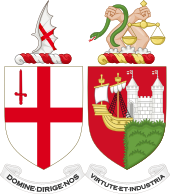 | |||||||||||||||||||||
 Map of the railway pre-grouping (1920) | |||||||||||||||||||||
 Map of the railway post-grouping (1926) | |||||||||||||||||||||
| History | |||||||||||||||||||||
|---|---|---|---|---|---|---|---|---|---|---|---|---|---|---|---|---|---|---|---|---|---|
| 1835 | Act of incorporation | ||||||||||||||||||||
| 1838 | First train ran | ||||||||||||||||||||
| 1869–92 | 7 ft 1⁄4 in (2,140 mm) Brunel gauge changed to 4 ft 8+1⁄2 in (1,435 mm) standard gauge | ||||||||||||||||||||
| 1903 | Start of road motor services | ||||||||||||||||||||
| 1923 | Keeps identity though the Grouping | ||||||||||||||||||||
| 1935 | Centenary | ||||||||||||||||||||
| 1948 | Nationalised | ||||||||||||||||||||
| Successor organisation | |||||||||||||||||||||
| 1948 | British Rail, Western Region | ||||||||||||||||||||
| Key locations | |||||||||||||||||||||
| Headquarters | Paddington station, London | ||||||||||||||||||||
| Locale | England; Wales | ||||||||||||||||||||
| Workshops | Swindon Wolverhampton | ||||||||||||||||||||
| Major stations | Birmingham Snow Hill Bristol Temple Meads Cardiff General London Paddington Reading General | ||||||||||||||||||||
| |||||||||||||||||||||
The fleet of Great Western Railway wagons was both large and varied as it carried the wide variety of goods traffic on the Great Western Railway (GWR) in the United Kingdom. This was the railway company that operated for the longest period of time in the country (from 1838 to 1947) and covered a large geographical area that included big cities such as London, industrialised areas including the West Midlands, areas of coal and mineral mining such as South Wales, and Somerset and other important agricultural districts.[1] In 1902 the company owned 59,036 wagons, and by 1926 this had risen to 88,580.[6]
The first wagons were just open boxes but covered vans were added from the 1860s and a wide range of special wagons were eventually built to handle many specialised traffics.[7] Towards the end of its existence these were all painted in a grey livery, but before that both black and red had been used at different times.
- ^ a b MacDermot, E T (1927). "Appendix 1". History of the Great Western Railway, volume I 1833-1863. London: Great Western Railway. Reprinted 1982, Ian Allan, ISBN 0-7110-0411-0
- ^ MacDermot, E T (1931). "Appendix 1". History of the Great Western Railway, volume II 1863-1921. London: Great Western Railway. Reprinted 1982, Ian Allan, ISBN 0-711004-12-9
- ^ "A brief review of the Company's hundred years of business". Great Western Railway Magazine. 47 (9). Great Western Railway: 495–499. 1935.
- ^ The Railway Year Book for 1920. London: The Railway Publishing Company Limited. 1920. p. 154.
- ^ The Railway Year Book for 1926. London: The Railway Publishing Company Limited. 1926. pp. 154–172.
- ^ Atkins, AG; et al. (1975). A History of GWR Goods Wagons. Vol. 1. Newton Abbot: David and Charles. ISBN 0-7153-6532-0.
- ^ Atkins, AG; et al. (1976). A History of GWR Goods Wagons. Vol. 2. Newton Abbot: David and Charles. ISBN 0-7153-7290-4.